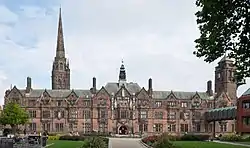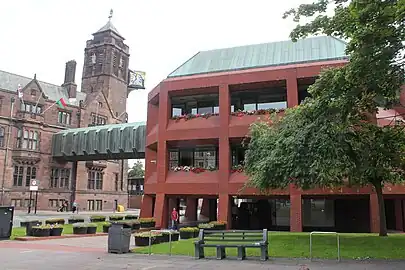| Council House, Coventry | |
|---|---|
The Council House | |
 Council House in its setting at Council House Square | |
| General information | |
| Architectural style | Tudor Revival |
| Classification | |
Listed Building – Grade II | |
| Designated | 24 June 1974 |
| Reference no. | 1342927 |
| Address | Earl Street |
| Town or city | Coventry |
| Country | United Kingdom |
| Coordinates | 52°24′26″N 1°30′28″W / 52.4072°N 1.5079°W |
| Construction started | 1913 |
| Completed | 1917 |
| Opened | 11 June 1920 |
| Owner | Coventry City Council |
| Technical details | |
| Floor count | 4 |
| Design and construction | |
| Architect(s) | Edward Garrett, Henry Walter Simister |
| Website | |
| www | |
The Council House, Coventry is a Tudor Revival style civic building which acts as the city hall of Coventry City Council and was built in the early 20th century. It is a Grade II-listed building.[1]
History
The Council House was commissioned to replace St Mary's Guildhall as the headquarters of the mayor and city corporation.[2] The site on Earl Street had previously been occupied by a row of shops.[3] A design for new municipal offices on the site was approved in 1895, but a dispute then arose as to whether shops should be incorporated into the ground floor of the new buildings; this was not swiftly resolved and, though the site was cleared, it remained vacant for over a decade.[4]
It was finally resolved to proceed without shops; the competitive process for a new design was announced in 1910 and won by architects Edward Garrett and Henry Walter Simister of Birmingham. The brief had been for designs to be submitted for both municipal offices and a town hall, to be envisioned 'as a single scheme' but with the caveat that the town hall might not (or not immediately) be built, as indeed turned out to be the case.[4]
The new Council House was designed in the Elizabethan style,[5] as stipulated by the Borough Corporation, to be in keeping with the old St Mary's Guildhall to the rear.[4] The foundation stone was laid on 12 June 1913 and the building was completed in 1917,[6] although, because of the First World War, the official opening by the Duke of York only took place on 11 June 1920.[7]
It was mainly an office building, designed to accommodate 1,500 people working across the various different municipal departments (ranging from the Town Clerk and City Treasurer to medical, police, education and waterworks officials); but it also contained large formal rooms such as the Council Chamber, Mayor's Parlour and various committee rooms, many of which were decorated with carvings representing the Forest of Arden.[4] The exterior was clad in Runcorn stone and roofed with Cotswold stone. A large clock tower was built, topped by a figure of St Michael; the clock was built by J. Smith & Sons of Derby, working to Simister's ornamental design (dated 1914, is a timepiece: although there is a capacious belfry there are no bells).[8]
Statues designed by Henry Wilson depicting Leofric (who founded monasteries in Coventry), Godiva (who was patron of the local monasteries) and Justice were installed above the entrance in 1924.[9][10]
During the Second World War, the bombings on the night of 14 November 1940, known as the Coventry Blitz, gave rise to some damage to the building including the destruction of the stained glass windows.[11] The former Duke of York returned to the Council House as King George VI to survey the damage in the aftermath of the raid.[11]
In September 2017 the council moved some 1,500 staff to its new 13-storey tower block at One Friargate.[12][13] They had previously been housed in a large Civic Centre complex, dating in part from the 1950s,[14] which had faced the east wing of the Council House, and which had latterly been linked to it by a metal walkway over Earl Street (dating from the 1970s).[15] The former Civic Centre was largely demolished after the council had moved out.[16]
Gallery
 The foundation stone dated 12 June 1913.
The foundation stone dated 12 June 1913. The interior corridors have decorative plasterwork and leaded windows
The interior corridors have decorative plasterwork and leaded windows The coat of arms of Coventry over the entrance to the Council House. Coventry's motto Camera Principis translates as "The Prince's Chamber", used because Coventry was regarded as the chamber of Edward, the Black Prince.
The coat of arms of Coventry over the entrance to the Council House. Coventry's motto Camera Principis translates as "The Prince's Chamber", used because Coventry was regarded as the chamber of Edward, the Black Prince. The former bridge link to 'Civic Centre 3'
The former bridge link to 'Civic Centre 3'
References
- ↑ Historic England. "The Council House, Coventry (1342927)". National Heritage List for England. Retrieved 1 October 2012.
- ↑ "St Mary's Guildhall". Culture24. Retrieved 1 October 2012.
- ↑ "Look: 100 years since work began on Coventry Council House". Coventry Live. 13 June 2013. Retrieved 27 July 2020.
- 1 2 3 4 "History of the Council House". Coventry City Council. Retrieved 18 April 2023.
- ↑ "Council House Called Late To Politics". Coventry and Warwickshire News. 23 August 2000. Retrieved 1 October 2012.
- ↑ "Coventry Council House". Visit Coventry and Warwickshire. Retrieved 1 October 2012.
- ↑ Orland, Rob. "Council House, Earl Street". Historic Coventry. Archived from the original on 4 October 2012. Retrieved 1 October 2012.
- ↑ "Clock tower on Coventry Council House". CoventryLive. Reach plc. Retrieved 18 April 2023.
- ↑ "The Council House". A History Tour of Coventry. Retrieved 5 April 2020.
- ↑ "Henry Wilson - the all round artist for Coventry Council House". Coventry Society. Retrieved 27 July 2020.
- 1 2 "Council House". Britain Express. Retrieved 5 April 2020.
- ↑ "Coventry council's new tower block at Friargate now completed". Coventry Observer. 21 September 2017. Retrieved 27 July 2020.
- ↑ "What will happen to Coventry Council House when new Friargate building is finished?". Coventry Live. 10 September 2015. Retrieved 27 July 2020.
- ↑ "Coventry Civic Centre". Twentieth Century Society. Retrieved 18 April 2023.
- ↑ "Watch: The moment Coventry's eyesore link bridge is torn down". CoventryLive. Reach plc. Retrieved 18 April 2023.
- ↑ "Watch machines tear down old buildings in Coventry city centre". CoventryLive. Reach plc. Retrieved 18 April 2023.